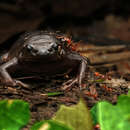Description
provided by AmphibiaWeb articles
Ctenophryne (formerly Nelsonophryne) aterrima is a medium-sized frog; adult males have a snout-vent length of 40-60 mm, while the larger females range from 50-70 mm. Distinguishing characteristics are the uniform, dark, glossy coloration of the upper surface and a short, narrow head on a rather pear-shaped body, as well as a transverse skin fold directly behind the eyes. This frog is the only microhylid in Costa Rica with a uniformly dark color, which can be dark brown, slate gray, or black. The venter is uniformly brown. The head is triangular in shape, with a rounded snout bearing nostrils near its tip. No vomerine teeth are present. Eyes are small with black irises and round pupils. The tympana are not visible. The arms are short, in contrast to the longer legs. Fingers lack webbing, but the toes are webbed and fringed. Toe tips are rounded. Neither fingers nor toes have expanded disks. A single large, spadelike tubercle is present at the base of the innermost toe, on each foot. No vocal sacs or slits are present. The skin has a thick, leather-like consistency. Breeding (gravid) females have white pustules around the cloacal area. Adult males have white pustules on the chin, finger edges, toes, and toe webs. Breeding males also have a rough whitish nuptial pad extending across the inside of the thumb, second and third finger, in addition to a nuptial gland covering the entire chest and abdomen and extending onto the ventral surface of the upper arms (Savage 2002; Leenders 2001). This species has a relatively large larva which can reach 44 mm in length at stage 37. The larval mouth is small and terminal, lacking beaks, denticles, and labial flaps. Nostrils are dorsally located. Distinct nasolacrimal grooves are present. Eyes are dorsolateral. The spiracular opening is located ventral to the gut, while the vent is located medially. The dorsum is brown, and the venter is transparent. Caudal fins are also transparent, but the caudal musculature itself is white. The tail fin ends in a blunt point (Donnelly et al. 1990).León (1970) reported that the karyotype is 2N=26.A Spanish-language species account can be found at the website of Instituto Nacional de Biodiversidad (INBio) (http://darnis.inbio.ac.cr/FMPro?-DB=UBIpub.fp3&-lay=WebAll&-Format=/ubi/detail.html&-Op=bw&id=4403&-Find).
- IUCN, Conservation International, and NatureServe. 2006. Global Amphibian Assessment. www.globalamphibians.org. Accessed on 11 August 2007.
- León, P. E. (1970). ''Report of the chromosome numbers of some Costa Rican anurans.'' Revista de Biologia Tropica, 17(1), 119-124.
- Sosa Bartuano, A., Guerrel, J. (2014). ''Ctenophryne aterrima-Diet.'' Herpetological Review, 45(4), 677-678.
- author
- Peera Chantasirivisal
Distribution and Habitat
provided by AmphibiaWeb articles
Black Narrow-mouthed Frogs are found in lowland and premontane rainforest of Costa Rica, Panama, Colombia, and Ecuador, as well as montane zones in Colombia and northwest Ecuador (Savage 2002), up to 1600 m above sea level (IUCN 2006). They prefer to shelter under surface litter on the forest floor, such as fallen logs (Savage 2002).
- author
- Peera Chantasirivisal
Life History, Abundance, Activity, and Special Behaviors
provided by AmphibiaWeb articles
Ctenophryne aterrima is mostly active during nighttime rainfall. This species is secretive and rarely seen, since it spends most of the time under leaf litter and surface debris. It is sometimes fossorial, as it has been found up to 80 cm below the surface. It is presumed to be insectivorous (Savage 2002). Recent observations have documented this frog consuming leaf-cutting ants (Genus Acromyrmex) in Panama (Sosa Bartuano and Guerrel 2014, includes photo).Mating apparently takes place during the early part of the rainy season (June to August), since gravid females have been collected during this period. The mating call is unknown, and vocal sacs and slits are lacking, so it is assumed that this species also lacks an advertisement call. Eggs have been examined from the oviduct of gravid females, but egg deposition has not been observed. The eggs, which were presumed to be mature, were black and yellow in color, and measured about 1.5 mm without their envelopes. Given that the tadpoles have been found in shallow water-filled depressions in the forest floor, the eggs must also have been laid in these depressions (Savage 2002; Leenders 2001).
- author
- Peera Chantasirivisal
Life History, Abundance, Activity, and Special Behaviors
provided by AmphibiaWeb articles
This species is not currently threatened and occurs in many protected areas. (IUCN 2006).
- author
- Peera Chantasirivisal
Ctenophryne aterrima: Brief Summary
provided by wikipedia EN
Ctenophryne aterrima (common name: Costa Rica Nelson frog, reflecting its earlier placement in Nelsonophryne) is a species of frog in the family Microhylidae. It is found in northwestern Ecuador, the Andes of Colombia, and lowland and premontane zones of Panama and Costa Rica to about 1,600 m (5,200 ft) above sea level.
- license
- cc-by-sa-3.0
- copyright
- Wikipedia authors and editors

